Mexico is an inexhaustible source of pre -Hispanic treasures findings. We continue to discover vestiges of the past practically every week and it is something that has shot with the Mayan train project and the latest technology tools. Thanks to the latter, we have been able to find hidden pyramids, underground areas and it is something that can give a push in the study of old structures.
However, there are pieces that, although we discover a few years ago, are still of great value. An example is the treasure of the tomb 7 of Monte Albán, which some continue to consider “the richest treasure in America.” Not only are hundred pieces, but they have a really enviable state of conservation.
The Mixteca Treasure of Tomb 7
In January 1932, Dr. Alfonso Caso discovered at the archaeological site of Tomb 7 of Monte Albán one of the biggest pre -Hispanic treasures in history. At the time of its finding, a first restoration was carried out, but care was also carried out both in 1944 and a few years ago, with the objective not only of studying the pieces, but of restoring those that were precise and carrying out an adequate conservation process.
In total, it is a set of more than 230 pieces made with sacred materials in the pre -Hispanic era, such as gold, silver, rock glass and precious stones such as turquoise, obsidian and green stone. The state of conservation of many of these objects is imposing. There are also less striking objects such as those made from bone or an alabaster pot.
But … Where do these luxury objects come from? INAH researchers offered context to the pieces, stating that their origins date from the union of a lord of the Zaachila dynasty and a Mixteca lady at some point between the years 1,200 and 1,400 after Christ.


Skull decorated with turquoise mosaics and shells


Rock glass glass


Locked bone with turquoise embedding
Specifically, from the National Institute of Anthropology and History they comment that it was a union between “Mr. 5 Flor, of the Zaachila dynasty, with the princess of the Mixteco kingdom of Teoxacualco, Mrs. 4 Rabbit ‘Quetzal'”. The princess would have used the tomb 7 as a sanctuary to deposit the twrappers in which the relics of the ancestors such as effigies of great value and other luxurious objects were kept.
And, judging by the photos of the articles, the princess’s treasure was not small, precisely. Now, when these articles were found, they did not look as well as in the photographs that accompany these lines. According to INAH, it was necessary and meticulous restoration process so that we can admire the details of each of these pieces.


Mask that represents the god Xipe Totec made in molten and soldier gold


A pot with support manufactured in alabaster


Bezote that represents the head of a jade stone foisan. The posterior plug is gold sheet
This includes the recovery of the properties of its color, the polished finish of some objects and the reflective power of others. In whatever work, work was worth it, since the collection has an imposing presence and, beyond the photographs that INAH himself shares on his website (where we can see descriptions of each object), they can be seen live in Room III of the Museum of Cultures of Oaxaca.
And, in addition to admiring the goldsmithing of each piece, it is interesting to note that this treasure is important because it demonstrates not only how certain materials already worked on what they gave importance, but some of them were achieved thanks to the exchange and trade networks between different Mesoamerican sites.
This is something extremely significant that, little by little, we are knowing and that tells us about the cultural wealth of some sites. A recent example is the study of the channels of Mexico City that, precisely, was an imposing cultural center thanks to these commercial activities.
Images | INAH
In WorldOfSoftware | The Maya played football. And now we know that under the courts they buried a hallucinogenic surprise
*An earlier version of this article was published in August 2024












